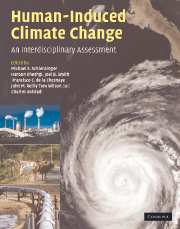Book contents
- Frontmatter
- Contents
- List of contributors
- Preface
- Part I Climate system science
- Part II Impacts and adaptation
- 9 Dynamic forecasts of the sectoral impacts of climate change
- 10 Assessing impacts and responses to global-mean sea-level rise
- 11 Developments in health models for integrated assessments
- 12 The impact of climate change on tourism and recreation
- 13 Using adaptive capacity to gain access to the decision-intensive ministries
- 14 The impacts of climate change on Africa
- Part III Mitigation of greenhouse gases
- Part IV Policy design and decisionmaking under uncertainty
- Index
- Plate section
- References
13 - Using adaptive capacity to gain access to the decision-intensive ministries
from Part II - Impacts and adaptation
Published online by Cambridge University Press: 06 December 2010
- Frontmatter
- Contents
- List of contributors
- Preface
- Part I Climate system science
- Part II Impacts and adaptation
- 9 Dynamic forecasts of the sectoral impacts of climate change
- 10 Assessing impacts and responses to global-mean sea-level rise
- 11 Developments in health models for integrated assessments
- 12 The impact of climate change on tourism and recreation
- 13 Using adaptive capacity to gain access to the decision-intensive ministries
- 14 The impacts of climate change on Africa
- Part III Mitigation of greenhouse gases
- Part IV Policy design and decisionmaking under uncertainty
- Index
- Plate section
- References
Summary
Introduction
The Conference of the Parties (COP) of the Framework Convention on Climate Change (UNFCCC) has begun to focus its attention on establishing mechanisms by which the incremental costs of adaptation to long-term climate change by developing countries might be supported by developed countries through their contributions to one or more adaptation funds. Meanwhile, the Intergovernmental Panel on Climate Change (IPCC), for the Fourth Assessment Report (AR4), has continued its interest in the interface between adaptation to climate change and climate variability, on the one hand, and sustainable development, on the other. Notwithstanding significant effort to promote cross-fertilization across these interests, it is not obvious that either process will, without some guidance, allow climate issues to gain access to the deliberations that are conducted behind the closed and sometimes locked doors of what might be termed the “decision-intensive ministries” – the ministries within which development planning is conducted and by which development policies are implemented. This short paper offers some thoughts (hypotheses, really) about how the climate community might use the emerging links between researchers' understandings of how adaptations work and practitioners' understandings of how attractive development might be promoted.
Of course, it is not the case of that decisionmakers concerned with development issues do not recognize the possibility that climate change may cause harm over the long term. The doors are closed primarily because the decisionmakers already have full plates. They worry about how to promote economic growth and productivity gains.
- Type
- Chapter
- Information
- Human-Induced Climate ChangeAn Interdisciplinary Assessment, pp. 156 - 160Publisher: Cambridge University PressPrint publication year: 2007



